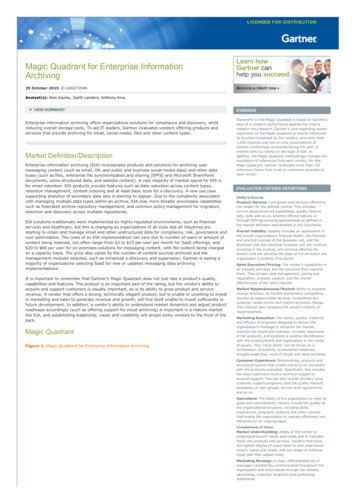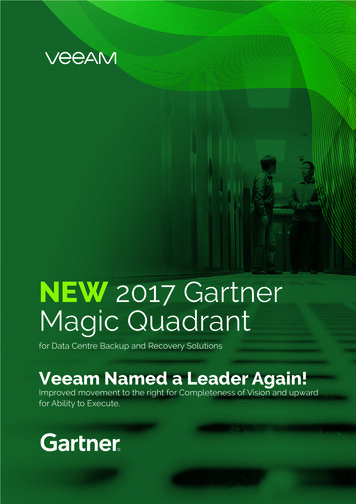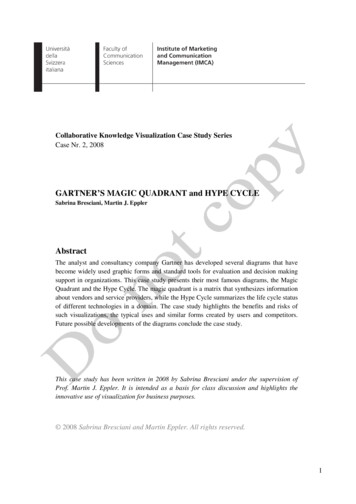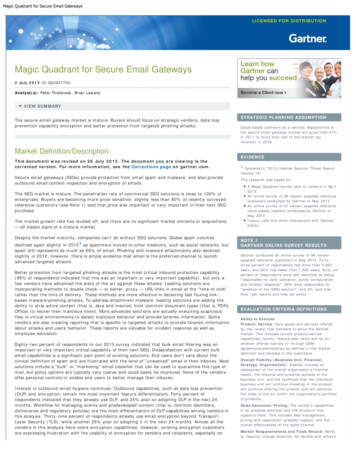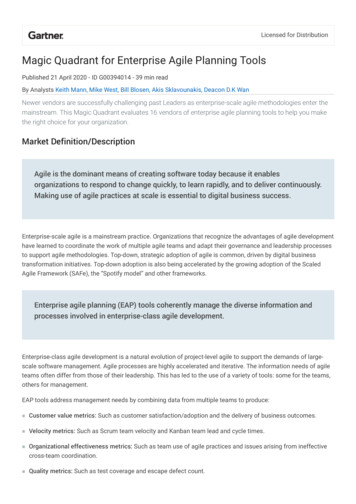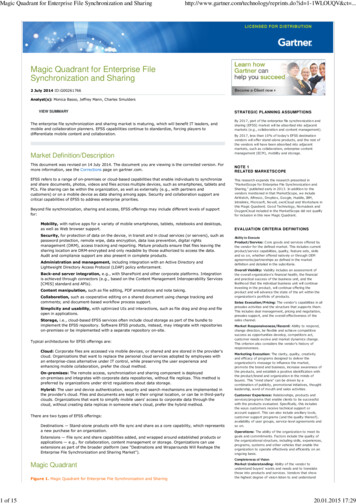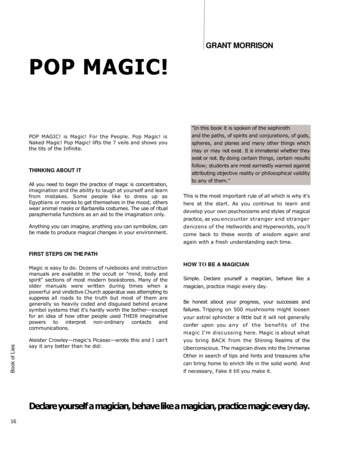
Transcription
Magic Quadrant for EnterpriseArchitecture ToolsPublished 9 November 2021 - ID G00742577 - 65 min readBy Gilbert van der Heiden, Akshay Jhawar, and 1 moreEA tools provide an enterprise metamodel and features tocontinuously evolve business and technology operating models.Enterprise architecture and technology innovation leaders shouldselect EA tools that support long-term business transformation,modernization and innovation goals.Market Definition/DescriptionThe EA tool market is expanding rapidly from a limited footprint. This is reflected inthe growth of the included vendors in this MQ, whose revenues have grown between15% and 30% in annual revenue since the last edition of this report was published.Due to its relatively small size and rapid growth, the market is prone to changes yearover year as vendors evolve their capabilities to address a growing number ofbusiness and IT stakeholders. Further, we see more support for such tools as EAextends its view of IT beyond the direct control of the IT department and into a wider,democratized technology environment across the organization.EA tools allow organizations to examine both the need for, and the impact of,change. They capture the interrelationships and interdependencies within andbetween an ecosystem of partners, operating models, capabilities, people,processes, information, and applications and technologies. They provide a centralrepository to capture data and metadata about the artifacts that an enterprise caresabout and their related life cycles. Models represent the relationships between theseartifacts and are themselves treated as assets that help describe and shape thefuture of the enterprise. EA tools help with investment decisions for both IT and thebroader enterprise. When models are combined with operational performance data,they can help improve business outcomes and shape the construction and ongoingdevelopment of digital platforms.EA tools must include features for (please see Critical Capabilities for EnterpriseArchitecture Tools for detailed descriptions): Repository: Provide a single source of truth for the organization with storage,categorization, and versioning of objects and model primitives of varioussorts, as well as the relationships between them and related business artifactsand views.1/35
Modeling: Structure relationships across entities, such as business strategies,objectives, goals, constraints, capabilities, personas, customer journeys,activities, processes, value streams, policies, decision models, metrics,applications, technologies, roadmaps, projects and programs. Analysis: Identify, assess, prioritize and track gaps, challenges, opportunities,and risks within and across portfolios of business capabilities, investments,processes, projects, applications and technologies. Presentation: Display and illustrate information in the form of dashboards,heat maps, models and scenarios that contribute to the presentation capabilityof the tool. Usability: Ease-of-use features and functions that enable support for variousclasses of users, including enterprise architects, analysts, business users,technology architects, strategy analysts and operations researchers. Configuration and management: Set up and administer the support andsecurity of the EA tooling platform, along with setting up different classes ofusers, their access rights and feature alignment. Extensibility: Extend the metamodel of the EA tool through the definition ofnew modeling primitives (concepts) and relationship types, up to newgraphical representations and enforcing domain-specific rules. Publication: Enabling wide consumption of the data contained within the EAtool, across the enterprise and beyond. This implies the ability to capturecomments and feedback on that content and/or score elements contained inrepository views. Frameworks: Apply EA, industry or other frameworks as a starting point forstructuring the repository and the relationships among artifacts. Integration: Expose and import data to and from other products, enabling theEA tool to be a hub uniting other common tools in the enterprise technologyecosystem. This includes categories such as product management, CMDB,PPM, business process management suite (BPMS) and process mining. Automation: Industrialize activities to deliver value more quickly and reliably,while keeping information current. Innovation management: Support the creation and tracking of innovation andchange initiatives, including ideation, trendspotting, and the engagement ofcolleagues, PPM links and benefits realization.EA Tools Enable Insights and Better Business DecisionsEA tools operate at many levels and across a wide spectrum to enable insights andsupport informed decision making. This spectrum includes but is not limited to: Business strategies, objectives, capabilities, competitors, ecosystem partners,and products/services, as well as the KPIs, metrics, risks and costs related tothem.2/35
Supporting technologies and applications, the services they offer, andinterfaces between them, as well as infrastructure providers and vendors thatprovide these things. Customer segments and stakeholder personas, customer journey maps, andthe processes, value streams and activities that the organization dependsupon to deliver value. Business scenarios, managing innovation, change and transformationprograms/initiatives, and including the individual projects and developmentsprints in IT.Increasingly, EA tools serve a wide range of stakeholders from the boardroom andthe C-suite, across all business strategic and operational roles, and into the ITestate. EA tools are also leveraged by a broad array of architectural and ITdisciplines — information, solution, security, applications and infrastructure.With such a broad array of stakeholders, EA tools must also facilitate theirconsumption of, and contribution to, the information contained within therepository. As they undertake their work, these users switch between an everexpanding set of views and visual representations of the datasets contained in therepository. Vendors employ different strategies to handle and represent the data andmetadata in the repository, including the use of: The classification, color coding and tagging of an object withiconography. Typically used to represent metadata about an object (forexample, maturity, complexity or state of an object in a business capabilitymap, business process, ecosystem map or change project). Grids to tabulate objects and aggregate metrics. Whether processes,ecosystems, capability maps or even a set of ideas, grids and lists provide asimple way to represent and edit data and metadata in the repository. Mosttools also include a grid interface to enable integration with Microsoft Excel asa baseline-level import/export mechanism. Many types of graphs to visualize data and metadata. Bubble charts are oftenused to contrast three different dimensions of metadata about a set of objects(for example, assessing business impact against maturity in the X and Ydimensions, with the size of the bubble capturing complexity). Similarly, a“funnel” might represent the life cycle of innovation ideas as they progresstoward projects or are killed off. Roadmaps and project plans to represent the path to a future vision and anydependencies. Vendors use both static and interactive Gantt charts, timelines,Kanban boards, processes, value chains and storytelling features to describehow the organization needs to deal with change. Filtering to support the needs of different business and IT users. Theseinclude synchronizing elements in a portal view or dashboard, whereselections made in one pane of the view (portal) are reflected in others. Both2D and 3D tools are used to traverse the different dimensions of repositorycontents (objects/assets) and the relationships between them. Filtering is alsoused to highlight elements related to an objective, plan, change or any asset3/35
of interest. At a graphical level, dendro diagrams and node maps allow usersto traverse repository contents.Due to the strategic importance and growth in the use of models in modern business,we expect to see some major vendors in adjacent market territories make strategicmoves by either buying or launching their own EA tools. It is also important to watchwhich vendors provide dedicated integration capabilities (such as APIs) and supportto allow EA tools to integrate with other enterprise solutions. This will strengthen theEA tools’ ability to govern business and IT operating model changes and guidestrategic decisions.Magic QuadrantFigure 1: Magic Quadrant for Enterprise Architecture ToolsSource: Gartner (November 2021)Vendor Strengths and Cautions4/35
ArdoqArdoq is a Leader in this Magic Quadrant. Ardoq’s product functionality is deliveredas a cloud-native SaaS solution. Its main operations and presence are in EMEA andgrowing in North America. Ardoq supports clients across multiple industries, withfinancial services and the public sector being the major ones. Its roadmap includesadding further use cases, scenario-based graph analytics, and increasing usabilityand engagement for non-EA users.Strengths Evolving metamodel development and deployment: The cloud-nativerepository is highly flexible and adaptable. The metamodel is developed anddeployed in an evolutionary manner, delivering just enough structure to meetthe use case need at hand. It benefits from cloud-native platform capabilitieslike a Git-style branching of architectural elements and models to createmultiple sequential or concurrent future states, and its in-memory graphdatabase to support complex analytics. User experience optimization: Ardoq keeps user experience and interaction atits core through a personalized UI, embedded storytelling functionality, a botto translate natural language questions in graph queries, and in-app chat forsupport. Its surveying and collaboration features are complemented by adedicated workflow integration capability for data ingestion from third-partyproducts, including ServiceNow and Jira. Use-case-based value delivery: Most clients start with Ardoq’s prepackageduse cases to address common business or IT challenges. Use cases providepreconfigured features including UI, analytics and visualization to reducetime to value against a defined IT and/or business problem.Cautions Flexibility comes at a cost: While access to features and functionalities withinArdoq is easily achieved through license plans, pricing is not. With numerousmodules/functionality add-ons, all with an associated price tag, contractingwith Ardoq requires intimate understanding of what is needed from the tooland how it will be used over time so as to maximize the value against thepotential cost increase. Limited region focused: Ardoq’s main marketing, sales and client focus is onEuropean and North American organizations with an existing EA function.This is also reflected in the hosting options of its product — either AWShosting in Ireland or the United States. It relies on partners for growth in otherregions. Prospective customers outside Ardoq’s main regions should verify itslocal partner capabilities as well as partner positioning with Ardoq to processlocal requirements, including regulations. Scaling support to maintain quality: Ardoq continues to recapitalize to fundexpansion, but roughly 75% of its resources are still Europe-based. With arelatively small team to engage and support its prospect, clients and partners,and some large marquee clients, scaling support of the business will be a5/35
challenge. Potential and existing customers should verify Ardoq’s approachand capabilities to sustain product performance and evolution.AvolutionAvolution is a Leader in this Magic Quadrant. Its ABACUS product is delivered as afully hosted SaaS solution, on-premises, or as a hybrid cloud offering. Withcustomers spread across several industries and regions, it has operations in EMEA,North and Latin America, and Asia/Pacific. Its roadmap includes enhancedmachine learning to improve its smart catalogues, support for non-EA roles modelingarchitectures, downloadable algorithms for different industries and use-case-specificmetrics.Strengths Intelligent approach to maintaining content quality: Avolution has acomprehensive metamodel based on graph database technology. Itapplies AI/ML to match and autocomplete or auto-adjust data with existingdata, or suggest values to structurally improve the quality of the repository.This capability increases enterprise-level data reliability. Commitment to customer co-creation: Avolution proactively engages withcustomers and partners to co-innovate ABACUS capabilities and processes,regularly releasing new features. Its approach to innovation is further reflectedin its AI and patent strategies, its support for academic research, and a varietyof initiatives to exploit innovative ideas from employees. Bundling features and capabilities per team size: Avolution has bundled itscore product features into three distinct propositions focused on the needs ofindividuals, small teams and large teams. With well-established operations inmost geographic regions, it allows Avolution to serve the needs of customersof different sizes globally.Cautions Complex pricing: Avolution offers ABACUS in a variety of user-and featurebased models, with tiered pricing and discounts. It also offers a-la-carteoptions, per-user-based pricing and paid add-on modules. This flexibilityrequires potential clients to assess their product use cases and expectedspending growth over time, as pricing rapidly can exceed initial investmentexpectations. Time-consuming: Although Avolution continues to take steps to simplify theexperience, it can still require a significant learning curve to set up andconfigure the metamodel as required, as well as understanding the modelingand visualization features. Lacking in-app support: ABACUS lacks the context-specific, in-app supportprovided by some of its competitors, which means that users must rely on aseparate ticket-based issue resolution mechanism to get support. In turn, thismeans that organizations must dedicate more resources to resolve issues andgenerate value.6/35
Bee360Bee360 (previously Clausmark) is a Niche Player in this Magic Quadrant. Its primaryEA product is called Bee360 and is available as on-premises, hosted or private cloudversion. Bee360 replaces Bee4IT, which provides tooling to help manage EA, ITfinance, and program and portfolio management (PPM) within a single repository.Bee360 has its main operations in EMEA and a service center in Asia/Pacific,supporting clients worldwide, with the majority of clients in the manufacturing,financial and energy sectors. Bee360’s roadmap focuses on improving process andproduct management capabilities and integration with DevOp toolchains.Strengths Pragmatic approach to support a variety of personas in the IT valuechain: Bee360 positions its product to support “holistic ITmanagement,” which implies providing insights to business and IT roles on ITstrategy and demand management, project execution, governance andbudgeting. Dedicated attention to improve collaboration: Bee360 has invested inintegration with communication and agile planning tools like Confluence andMicrosoft Teams to improve agile-based transformation activities, supportedby Kanban boards and simplified model relationship management to rapidlyprocess changes. Attention to user adoption: Bee360 includes dedicated training andenablement features to reduce the learning and adoption time of the productand its features. It supports adding context and explanation to the customer’sown meta-model and assets, as well as predefined content for standardbusiness and IT processes to apply in modeling as well as training.Cautions Main focus on IT management: Bee360’s main features and capabilities arefocused on maximizing value from IT. It offers limited predefined assets forbusiness architecture, where business capabilities and a broader businessdesign play an important part in delivering on business outcomes and definingbusiness operating models. While Bee360 allows the creation of all thenecessary artifacts, these are not readily available. No embedded industry- or regulatory-specific assets: Bee360 has noembedded industry-specific assets, nor embedded coverage for industry orregulatory frameworks. It relies on individual account manager experienceand its partner capabilities to address industry demands. Single enterprise license model only: Bee360 is only available as anenterprise license that includes all functionalities and features, without anyadditional options or add-ons. While this is a strategic company choice, itequally creates challenges for organizations with existing products forfunctions like PPM or financial management, which would require integrationeffort and reduce the value of the product.BiZZdesign7/35
BiZZdesign is a Leader in this Magic Quadrant. The BiZZdesign product HoriZZon isdelivered as a fully hosted SaaS solution, on-premises, or as a hybridconfiguration. Its main presence is in EMEA and is growing in North America.BiZZdesign targets and predominantly focuses on financial services andgovernment/defense sectors. Its HoriZZon product roadmap includes role-specificdecision support, enhanced data maintenance via process automation, and acontinued focus on security architecture.Strengths Cloud deployment benefits: BiZZdesign completed the migration of HoriZZonto a cloud-based, multitenant, distributed platform architecture in 2021. Themigration has elevated the availability and resiliency of HoriZZon, enabled amore frequent cadence of updates, and offers further configurability andextensibility. Drives innovation through customer experience: BiZZdesign has invested in anew customer experience research team and, as a result, has increased thethroughput of ideation, prototyping, testing and validation of new ideas. Thestrategy has resulted in incorporating the use of ML in model creationand additional solution packs focusing on assessing operational resilienceand organizational change capability. Industry expert partnerships: BiZZdesign partners with different subject matterexperts to create industry-specific assets. This includes creating BusinessArchitecture Body of Knowledge (BIZBOK) industry models and partneringwith NATO on the development of an ArchiMate framework for defense, aswell as creating financial services regulations driven by operational resilienceassets and expanding the Open Group aviation reference architecture.Cautions Limited geographic presence: While using a partner network to support globalgrowth, the majority of BiZZdesign sales effort and resources reside in andfocus on EMEA and North America. Other regions are predominantlyrepresented by third-party partners. Complex pricing: BiZZdesign has developed a modular platform with a lowprice entry-point, but to get enterprisewide value and neededfunctionality, HoriZZon software costs can rise quickly. Although providingextra flexibility, the combination of module, credit-based pricing, license-typeand consulting can be confusing for customers. Limited operational support: With its focus on North America and EMEA,BiZZdesign’s support capability is limited outside these regions. While it offers24/7 SLA-based support for critical incidents, its main SLAs provide localoffice hour support only. High availability comes at a premium based on apercentage of total spend. Prospective customers should ensure that the SLAthey agree to includes support for the hours they need for their business, inevery region they require the support.BOC Group8/35
BOC Group is a Leader in this Magic Quadrant. Its product, ADOIT, is offered as afully hosted SaaS solution, on-premises, or as a hybrid cloud proposition. Themajority of its clients are in EMEA, with a growing presence in North America andAsia/Pacific. ADOIT customers are spread across multiple industries. ADOIT’sproduct roadmap includes ongoing UX enhancements and support for EA asinternal consultancy through EA service delivery and security managementtechniques such as threat modeling.Strengths Maturity-based, bundled offering: BOC Group has revamped its offering toprovide three distinct options for customers starting, growing and expandingEA practice capability and maturity. There is also a “freemium” offering,ADOIT Community Edition, which led to a complete UI overhaul with focuson intuitiveness and accessibility, alongside in-tool user guidance for keyvalue-adding use cases. Simple licensing and pricing: BOC Group is rebranding and repositioning itsoffering to a user-driven growth strategy. ADOIT now focuses on two usertypes: contributors and readers. The pricing model is transparent, starting witha low-cost option to help customers transition from the freemium edition topaid plans. Innovations to support evolving multilingual market needs: ADOIT includesinnovative features such as the model time filter to dynamically observemodels at different points in time with AI-based recommendations. Its go-tomarket strategy includes multilingual capabilities (currently English, French,German, Polish and Spanish) to provide more dedicated local languagesupport.Cautions Rebranding capabilities: BOC Group is rebranding ADOIT to a userfocused proposition. It needs to educate and support existing clients, as wellas increase its assets and partner capabilities for the new persona-focusedproposition. Limited geographic footprint: BOC Group has the majority of its operationalresources in Austria and Germany, and its customers are predominantlybased in Europe. It applies a centralized delivery model with partners forregional support. Organizations with global distributed operations willtherefore need to assess the combined support capabilities from BOC Groupand its partners. Limited cloud capabilities: ADOIT is a traditional client/serverarchitecture. While BOC Group indicates it is a simple architecture that caneasily be deployed and scaled through Amazon Web Services (AWS), IaaSservices like EKS and S3, it is still a traditional compiled Microsoft Windowsapplication that runs in containers. While planning to add non-Europeanhosting options, ADOIT currently is only provided on Europe-focused AWSavailability zones and through a dedicated private cloud provider inSwitzerland.9/35
CapsifiCapsifi is a Leader in this Magic Quadrant. Its product, Jalapeno, is primarilyavailable as a SaaS offering. Capsifi operations are largely Asia/Pacific-based, witha growing presence in North America and Europe. Its clients are predominantly inthe financial services, insurance, telecom, retail and public sector. Jalapeno’sroadmap includes interactive collaboration tools, enhanced digital business modeldashboards and consoles, and continued investment in APIs and AI-inferredinsights.Strengths Focus on adapting to continuous change in customers: With continuouschange as a guiding design principle, Jalapeno is built around a semanticallyaligned knowledge graph and an ontology for business change. It supports awide range of functionality, including role specific consoles with contextualinsight to manage business innovation and transformation. Differentiating partner model with distinct industry focus: Capsifi integratespartner industry assets into the product platform and creates tailored industryassets and customized product versions for global partners to allow forpartner-specific services. This approach improves partner commitment anddelivers capabilities to Capsifi and partner clients faster. Implementation pathways reduce time to value: Capsifi has created multipleJalapeno implementation templates to shorten time to value for clients, whichit calls “pathways.” These templates reflect the most common use cases forbusiness transformation, including setting strategic directions, optimizingoperations, defining and building transformation capabilities, capturing andbenefiting from the customer insights, and governing all changes.Cautions Sustainable quality with rapid growth: Capsifi added more than 63% of uniquecustomers over the past year. Considering its small size, roadmap of changesand limited partner support capabilities, it is challenged to maintain productand support quality. Potential and existing customers should verify Capsifi’sability to sustain product investment and enhancement. Implementation services at a cost: Capsifi offers dedicated product coachesas first point of contact for onboarding and ongoing support. However, suchcoaches are not included by default, nor are the professional servicesassociated with the deployment of Jalapeno implementation pathways.Without these services, implementing Jalapeno and realizing its benefits willbecome more of a trial and error process. Regulatory compliance: Capsifi has received SOC-2 compliance at companylevel and is preparing for ISO27001 certification in 2022. However, it does notintend to cover common regulatory frameworks like GDPR, IST orPCI/DSS. Capsifi indicates framework content can be imported, but that doesnot imply clarity on actual compliance. Especially with a focus on cloud-basedservices and digital business operations, Capsifi will need to ramp up itsregulatory capabilities.10/35
Enterprise Architecture SolutionsEnterprise Architecture Solutions (EAS) is a Visionary in this Magic Quadrant. Itsproduct is based on the installable open-source “Essential Project,” with licensededitions delivered via public cloud or as a Docker instance for on-premises or privatecloud. With a small user base spread across Europe, North America andAsia/Pacific, it derives the majority of its revenues from customers in government,retail, financial services and entertainment. The Essential roadmap includes supportfor virtual workspaces, AI/ML-based advice, comparative analysis of digitalinnovation options and integration with SaaS security management tools.Strengths Highly disruptive approach to pricing: As a full open-source solution,its pricing model is not per-user-based, rather it uses a fixed low subscriptionfee independent of the number of users. EAS positions its tool as an enablerof enterprise architects and closely aligns it with its EA consulting services.While for small teams there are lower cost propositions in the market,Essential’s pricing becomes unrivaled with a growing user base per clientorganization. Supporting wider collaboration with non-EA and IT stakeholders: EAS hasfocused investments on simplifying enterprisewide collaboration. It hasexpanded its role- and persona-based insights and provides, for free, formatcommenting and ideation aligned with the enterprise metamodel. This allowsfor better alignment across the enterprise and enables coordinated changeand a rationalized IT portfolio. Empowering users through customized client playbooks: EAS uses lessonslearned from its EA consulting services to improve its tool applicationplaybook for new clients. Through a rule-based, engine-driven survey,Essential provides clients with a specific playbook on their most effective pathto realize value with the tool, given their EA maturity, goals, stakeholderengagement levels, and access to and quality of data.Cautions More demand than it can service: The disruptive business and pricing modelof EAS potentially creates more demand than it can operationally service in afinancially viable way. For long-term success, the vendor needs to focus itsefforts on partner recruitment and growing the skills and competencies ofthose partners. Relying on its own metamodel: EAS primarily relies on its framework-agnosticmetamodel. It does provide some American Productivity & Quality Center(APQC) industry models and its own industry templates, but no standardcontrol or delivery frameworks or templates. To rapidly ramp up Essentialbenefits, potential clients should first assess if Essential’s self-service optionsor EAS consulting capabilities support their use case. Scaling business operations: EAS must consider scalability of the business,carefully allocating its limited resources and ensuring all investments continue11/35
to drive broader enterprise adoption and encourage more of its open-sourceusers to convert to paid offerings.erwin by Questerwin by Quest is a Niche Player in this Magic Quadrant. The erwin product is callederwin Evolve and is available as a SaaS, on-premises or hosted offering. With itsuser base predominantly in Europe and North America, erwin derives most of itsrevenues from banking, finance and pharmaceutical clients. The roadmapfor erwin Evolve includes an improved user experience and modeler capabilities. Inaddition, erwin plans to release a SaaS alternative for erwin Evolve, erwin Evolve360.erwin was acquired by Quest Software in January 2021.Strengths Market and product expansion potential through acquisition: Through theQuest acquisition, erwin benefits from a larger sales force and access toQuest IP and integration into the Quest portfolio, and erwin Evolve can furthergrow its data intelligence and governance functionality. Focused industry and enterprise approach: erwin targets large enterprises inhighly regulated industries with complex data and processes, where datagovernance and compliance are critical. It has invested heavily in a library ofprebuilt erwin Evolve models supporting transformation initiatives, based onindustry or domain frameworks like DoDAF, ITIL, eTOM or HIPAA. Continued attention to improving the user experience: Whileerwin indicates major changes through its erwin Evolve 360 platform, this hasnot stopped it from investing in its current erwin Evolve product. It introducedreal-time analytics options, data-driven visualizations, modeler integrationsfocused on consistent data across client systems, and improved security andauthentication features.Cautions Major improvements expected: erwin has indicated major changes in t
to allow EA tools to integrate with other enterprise solutions. This will strengthen the EA tools' ability to govern business and IT operating model changes and guide strategic decisions. Magic Quadrant Figure 1: Magic Quadrant for Enterprise Architecture Tools Source: Gartner (November 2021) Vendor Strengths and Cautions
